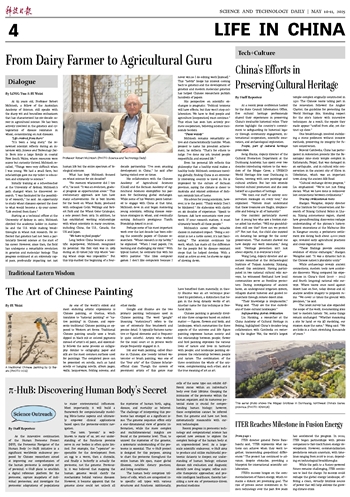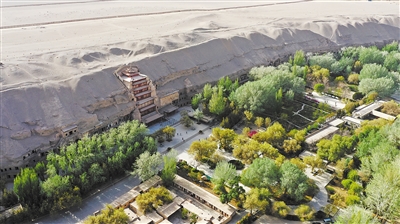
 |
| This aerial photo shows the Mogao Grottoes in Dunhuang, northwest China's Gansu province. (PHOTO: XINHUA) |
At a recent press conference hosted by the State Council Information Office, five cultural heritage professionals shared their experiences in preserving China's invaluable historical relics. Their stories highlight the country's commitment to safeguarding its historical legacy through community engagement, international cooperation, scientific innovation, and archaeological exploration.
People, part of cultural heritage protection
Song Shuxia, deputy director of the Cultural Promotion Department at the Dunhuang Academy, has spent over two decades introducing visitors to the wonders of the Mogao Caves, a UNESCO World Heritage Site near Dunhuang in Gansu, teeming with cave paintings and cultural artifacts. But her role extends beyond cultural promotion and she sees herself as a guardian of heritage.
"We train our staff to convey conservation messages on every tour," she explained. "Visitors must understand that these treasures are fragile, irreplaceable and belong to all of humanity."
One incident particularly moved her. A young boy who saw a broken statue asked his mother, "Will my grandchildren still see this? How can we protect it?" Not just that, the child also insisted on donating his savings for the caves' preservation. "That moment showed me how deeply our work resonates," Song said. "Heritage protection isn't just about experts, it is everyone's duty."
Wang Long, deputy director and associate researcher at the Archaeological Institute of Turpan Academy, Xinjiang, echoed this sentiment. Having participated in two national cultural relic surveys, he witnessed firsthand how local communities serve as frontline protectors. During investigations of ancient karez, an underground irrigation system, villagers shared histories and guided researchers through remote desert sites.
"Their knowledge is irreplaceable," Wang said. "They are the true custodians of these cultural landscapes."
Safeguarding global civilization
Liu Hanxing, a researcher at the China Academy of Cultural Heritage in Beijing, highlighted China's decades-long collaboration with Cambodia on restoring the Angkor Wat, the world's largest temple complex originally constructed in 1150. The Chinese teams taking part in the renovation followed the Angkor Charter, the guideline for protecting the World Heritage Site, blending respect for the site's history with innovative techniques. As a result, the repairs they made appear "unified from afar, yet distinct up close."
One breakthrough involved stabilizing a stone pediment without invasive methods, preserving its integrity for future conservation.
Beyond Cambodia, China has participated in restoration projects like the Basantapur nine-story temple complex in Kathmandu, Nepal, that was damaged in an earthquake, and in cultural relic conservation in the ancient city of Khiva in Uzbekistan, which was an important town along the ancient Silk Road.
"Cultural exchange drives progress," Liu emphasized. "We're not just fixing stones. What we have done is rediscover lost connections between civilizations."
Tracing civilizational roots
Shargan Wangdue, deputy director of the Institute for Conservation and Research of Xizang Cultural Relics in Lhasa, Xizang autonomous region, shared how groundbreaking discoveries reshape understanding of the plateau's history. Recent excavations at the Mabucuo Site in Kangmar county, a prehistoric settlement site dating back about 4,000 years ago, revealed early agricultural practices and cross-regional trade.
"These findings provide concrete evidence of ethnic exchanges," Shargan Wangdue said. "It was a dynamic hub in the Chinese nation's pluralistic unity."
While archaeology reveals ancient connections, modern tools now accelerate discovery. Wang compared his experiences in China's third (2007–2011) and fourth (ongoing) national relic surveys. Where teams once raced against desert heat on foot, today drones and AI analyze satellite imagery to pinpoint ruins. "We cover 10 times the ground with precision," he said.
The latest survey has also expanded the scope of the work, documenting sites tied to modern history. Yet, some things remain unchanged. "Whether measuring a site by hand or via 3D modeling, our mission stays the same," Wang said. "We are links in a chain stretching thousands of years."







